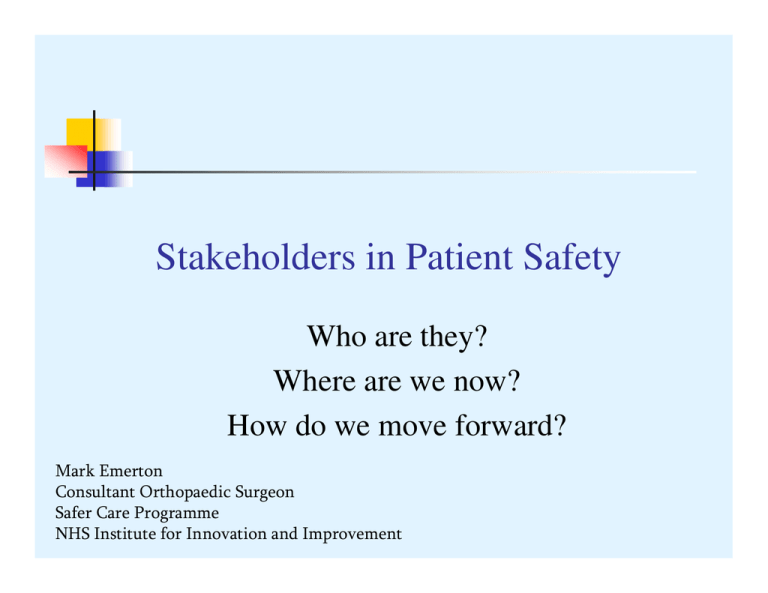Stakeholders in Patient Safety Who are they? Where are we now?
advertisement

Stakeholders in Patient Safety Who are they? Where are we now? How do we move forward? Mark Emerton Consultant Orthopaedic Surgeon Safer Care Programme NHS Institute for Innovation and Improvement Who are the stakeholders ? Patients Clinical Staff Consultants Managers Commissioners Patient Safety Leaders Professional bodies 2 Who are the stakeholders ? Patients Clinical Staff Consultants Managers Commissioners Patient Safety Leaders Professional bodies 3 Stakeholders Universities Regulatory bodies Deaneries Providers of HF training DoH Patient groups 4 Patients Empowered to ask and contribute Involved with decision making Informed Understanding of expectations ↑ outcomes ↓ LOS ↓ cost ↓ litigation 5 Clinical Staff Good teamwork Receptive Enthusiastic hierarchy flatteners! No HF awareness nor formal training 6 I’m fed up with that idiot not telling me what’s going on Human factors…hmmm. That’s everything to do with being human isn’t it? Don’t talk to me about bl**dy timeouts, I’VE GOT A LIST TO DO. I am not a ******* pilot!! 7 The state of play! 8 Surgery Same kit Same assistant and scrub nurse Same theatre Same anaesthetist Same CD playing Same implant Same cement Same sutures Same dressing “…… the challenge is to make every procedure the same as last one.” 9 The perfect operating list Effortless Never asking for anything Quiet Very fast but not rushed Happy Smooth No glitches Good outcomes 10 The average operating list A struggle Many items not immediately available Noisy Rushed but not very fast Aggravating Stop start Blame Sub-optimal outcomes 11 The Professional Bodies 12 13 14 Safety and Leadership for Interventional Procedures and Surgery (SLIPS) 15 We define medical professionalism as a set of values, behaviours, and relationships that underpin the trust the public has in doctors. We go on to describe what those values, behaviours, and relationships are, how they are changing, and why they matter. This is the core of our work. We have also identified six themes where our definition has further implications: leadership, teams, education, appraisal, careers, and research. There is relatively little knowledge about how teams of health professionals operate in practice. What evidence there is suggests that teams are not even close to fulfilling their real potential. Ethnographic research in hospital settings, for example, shows that collaboration between professional groups is usually short-lived, unstructured, opportunistic, fragmented, and rushed.45 16 The state of play Recognition of failure A sense that there is a better way Increasing no. of resources but Little movement in culture of healthcare No widespread change in training No legislative drive to improve skills 17 Managers / PSMs Little focus on HF Unaware of link to quality Consider it a luxury Don’t understand business case for safety Safety ≡ Risk management and Audit 18 Stakeholders requirements To engender human factors thinking in the hearts and minds of all healthcare staff and stakeholders. From board to ward and beyond… …… to improve patient safety by reducing the possibility and impact of errors. CHFG aim & mission statement 2008 19 What do we need? Raise awareness Harmonise the message Demonstrate the potential Recognise we can learn from other industries Establish HF education at all levels of training Support the move to quality based commissioning Link successful HF training and practice with appraisal and revalidation 20 Questions Managing different cultures Physician professionalism and team function Create a similar mindset for non-catastrophic events as catastrophic Standardisation Vs prof. autonomy Corporate attitudes Dependence on p<0.05 Create a population of individuals trained to function in multiple teams Getting patients involved 21 22




